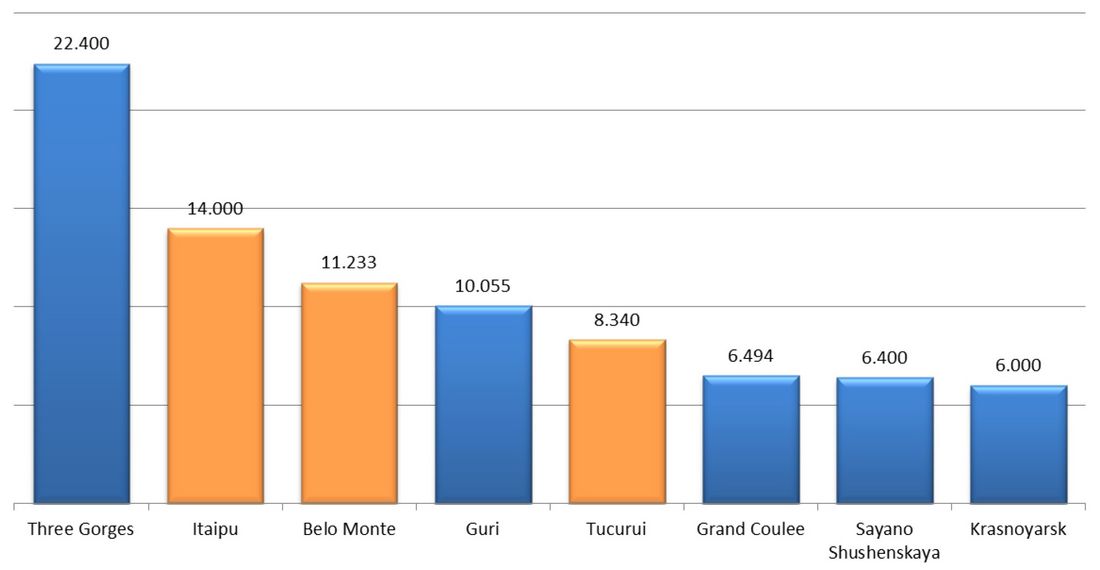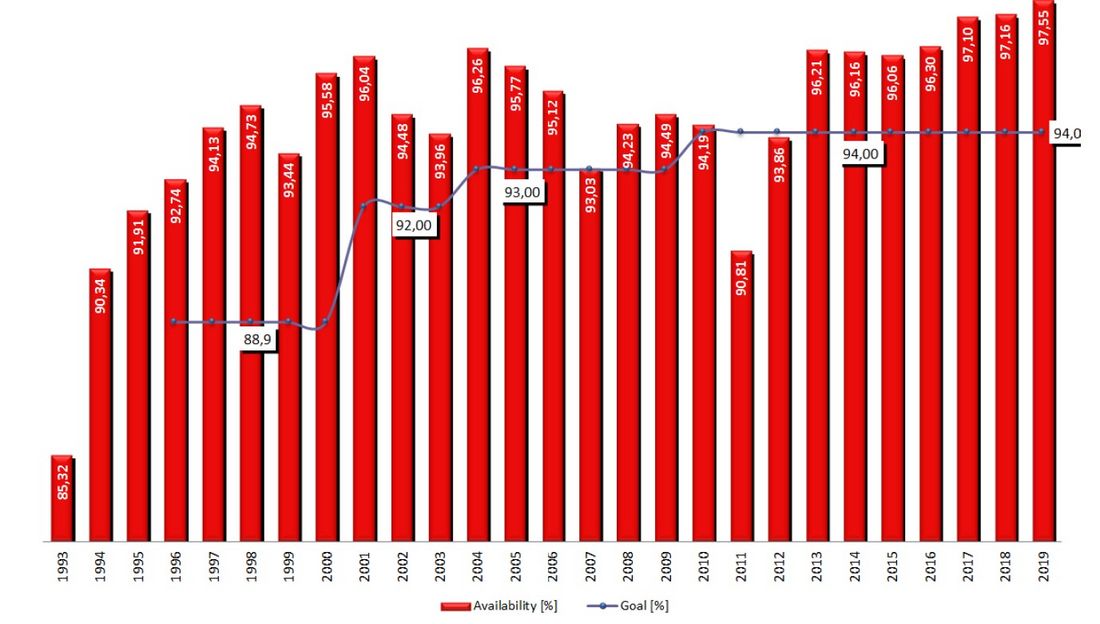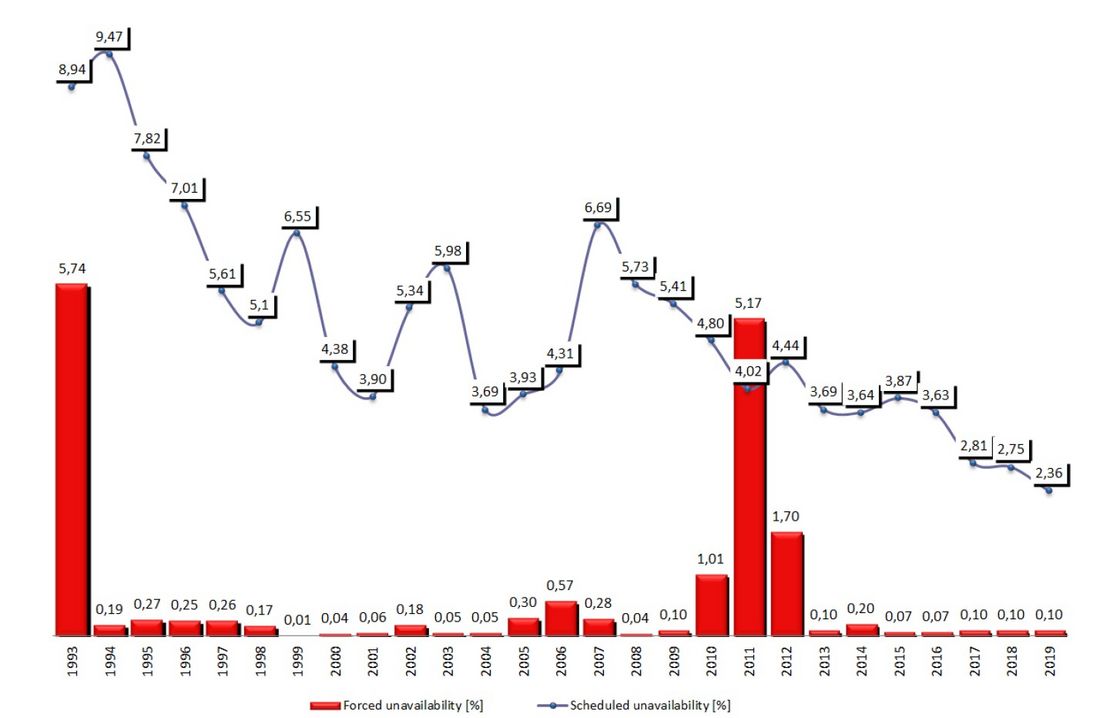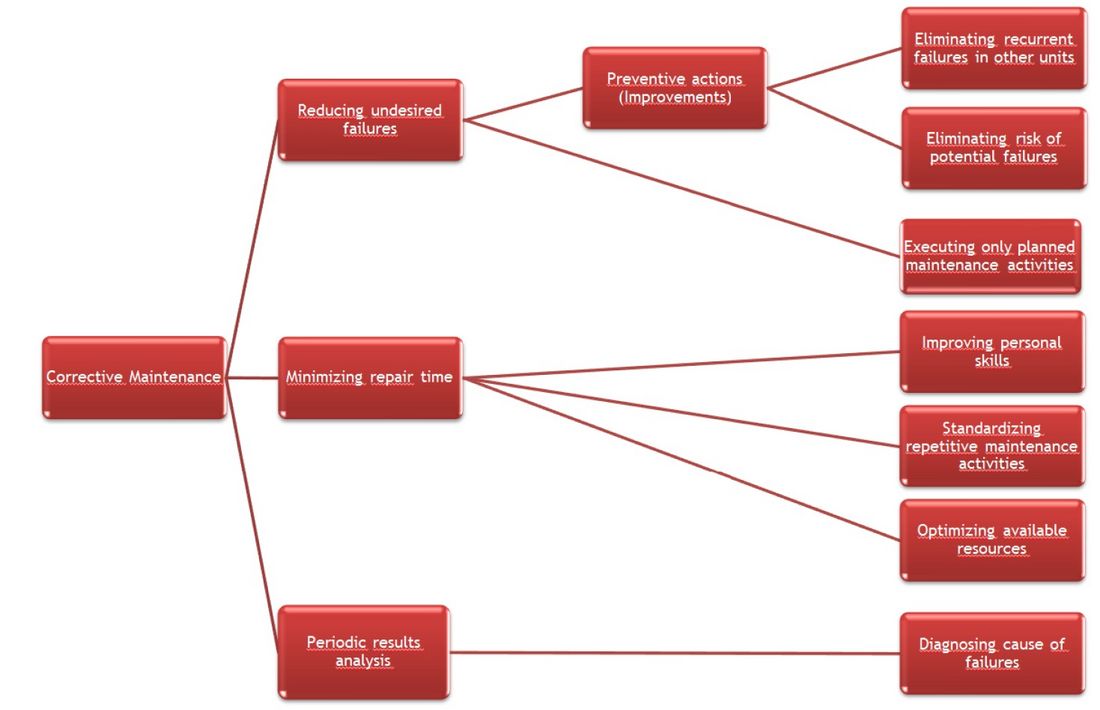The evolution of the maintenance processes increases the operational availability and contribute to the operational efficiency of Itaipu Power Plant
Authors
M.A.S. MAURO, C.S. PIMENTA, R.A. GARCETE M. - Itaipu Binacional, Brazil
J.J. ROCHA E. - Trassínio Consultoria, Brazil

Summary
The Itaipu hydroelectric power plant, with a 14000-MW installed capacity, occupies a strategic position in both Brazilian and Paraguayan electrical systems and was responsible in 2019 for supplying 11.3% of the energy consumed in Brazil and 88.1% of the Paraguayan demand.
Due to the relevance and the strategic position for the two countries, the Maintenance Superintendency of Itaipu Binacional has been constantly improving its processes to ensure increasingly higher indicators of availability of the generating units. Over the last 6 years these indicators have always been above 96%; in 2017, 2018 and 2019 the availability exceeded 97% (97.10%, 97.16% and 97.55% respectively). This fact, combined with the operational efficiency, made possible excellent production numbers with energy efficiencies of 98.09%, 99.30% and 99.55% respectively.
Especially in the year 2016, the energy production reached 103,098 GWh, Itaipu’s highest annual mark, thanks to the convergence of four important factors: i) energy consumption in Brazil (472,242 GWh); ii) the availability of the transmission system under FURNAS responsibility; iii) hydrologic availability in Itaipu (107,176 GWh); and iv) mainly the generating units availability optimization (96.30%). These factors led to a production performance of 96.20%.
As can be seen, from the four factors presented above, the only one which can be managed directly by Itaipu is the generation availability. There for this paper portrays the experience of the Maintenance Superintendency of Itaipu Binacional in:
- Reassessing the processes and activities performed during periodic (scheduled) maintenances;
- Avoiding delays in periodic maintenances;
- Reducing downtime for corrective and preventive interventions;
- Reducing unwanted failures.
It should be noted that the balance between availability, reliability and costs involved in the equipment maintenance and operation processes is a constant management concern. Furthermore, the obsolescence of electric and electronic equipment cannot be neglected. That is why Itaipu is currently carrying out the technological update of its power plant, focused mainly on protection and control systems.
Keeping state-of-the-art hydraulic generation technology as well as auxiliary equipment in a power plant the size of Itaipu is a complex and challenging activity which has required a strategic follow-up by directors and board members.
The target is to make sure that the power plant equipment maintains its reliability and company's high-performance continuity over the next decades, with equal or even higher energy production figures and immediate repercussions on the economy of both partner countries. Hence, the greater the production of hydroelectric power plants, according the example for by Itaipu, smaller is the risk of Brazil and Paraguay to resort the more expensive and mainly environment-harming sources, such as thermoelectric plants.
The importance of maintenance to guarantee the technological update project is present in Itaipu’s energy production results. Until 2012, an average of 290 days of units downtime per year were necessary to comply with the preventive maintenance program of the generating units. With the improvement of the processes this downtime has been falling. From 2019 on, an average of 173 days are required, i.e. a 40% downtime reduction, which is significant not only from a financial point of view but mainly for the flexibility it brings to the operation and the technological update.
This scenario will serve as the background to present the good maintenance practices consolidated in Itaipu over more than 30 years of operation, during which the search for the surpassing of performance indicators transcend the energy generation and include factors such as teams motivation (reflecting on low turnover), training, knowledge management and the integration of the plant with its social environment.
Keywords
Availability, reliability, costs, optimization, scheduled maintenances, interventions1. Introduction
In the ranking of large hydroelectric plants (Figure 1), Itaipu, a run-of-stream dam, is currently the second largest plant in installed capacity, behind only the Chinese Three Gorges power plant. Despite having a 38% smaller installed capacity, thanks to the integrated management between operation and maintenance Itaipu was the first to overcome the 100,000 GWh barrier of annual electrical generation, reaching in 2016 the mark of 103,098 GWh.

Figure 1 - Itaipu and the world’s large hydroelectric power plants
The increase in electrical energy consumption over the last decades, shown in Figure 2, both in the Brazilian and the Paraguayan markets, equal partners of the venture, combined with the responsibility of Itaipu hydroelectric plant in meeting this demand, makes the Maintenance Superintendency constantly seek the improvement of its processes in order to ensure high availability indicators of the generating units, thereby positively contributing to this power supply.

Figure 2 – National electrical energy consumption by sector [GWh] -
Source : Itaipu Binacional and Empresa de Pesquisa Energética - EPE
The electric energy production process is strongly controlled by three indicators, namely:
- Availability – percentage of time an equipment or system is able to perform its required function; or the probability that at any given moment the equipment or system is in the available state;
- Scheduled unavailability – percentage of time the generating units are out of service for scheduled maintenance;
- Forced unavailability - percentage of time the generating units are out of service due to forced shutdowns.
In this context, there are four control factors that directly affect the behaviour of the indexes mentioned above:
- Energy consumption in Brazil and Paraguay;
- Availability of the transmission system, under the responsibility of FURNAS;
- Water availability at Itaipu; and
- Mainly the optimization of the availability of the generating units.
As can be seen, of the four factors presented above, the only one that can be managed directly by Itaipu is the availability of generation.
2. Maintenance superintendency management
Itaipu Binacional’s Operation and Maintenance System (SOM) aims to:
- Permanently control the performance of equipment and structures;
- Rationalize the execution of operation and maintenance activities;
- Establish procedures for all repetitive actions which involve complexity, risks and high costs;
- Monitor and optimize production costs;
- Train the team.
Several challenges exist in the daily life of the maintenance and operation teams, such as:
- Continuous improvement of performance indicators;
- Market in continuous growth;
- Renewal of staff;
- Skills development;
- Implementation of new systems;
- Technological update.
Among these challenges we can highlight, especially in the last five years, the search for a continuous improvement of performance indicators.

Figure 3 – Operational availability
In order to improve and to consolidate the availability-indicators of the generating units of Itaipu practiced until 2010, the Maintenance Superintendency accomplished several studies aiming to mitigate the deviations that caused an increase in forced unavailability, as shown in Figures 3 and 4.

Figure 4 – Unavailability
With the help of modern maintenance techniques and concepts such as reliability-centered maintenance, studies were conducted to optimize the maintenance plan developed and applied by Itaipu. However, due to the importance of the generating units of Itaipu to the electrical systems of Brazil and Paraguay, the maintenance technical staff has always been very conservative regarding the new maintenance techniques.
With an unexpected event at generating unit 06, which made it unavailable from September 2010 to March 2012, the Maintenance Superintendency took the opportunity for a direct action of all its technical staff aiming at:
- On-the-job training through the disassembly and reassembly of generating unit 06 to replace the turbine wear ring;
- Verification of the effectiveness of maintenance processes through thorough and detailed inspection of inaccessible parts;
- Validation of maintenance engineering studies.
This approach and strategy were decisive for a singular progress, breaking paradigms and seeking improvement, resulting in the general review of the procedures adopted and implemented in the preventive maintenance of the generating units of Itaipu, whose gains and implemented actions will be detailed below.
2.1 Actions to reduce the forced unavailability
With the intention of reducing forced unavailability, two fronts of action were illustrated, illustrated in Figure 5, to group the main actions aiming at possible performance gains.
The first group groups actions to reduce untimely failures. Potential needs for improvement were raised, ranging from the elimination of recurring failures to the premise of executing only planned activities, breaking paradigms of taking advantage of stops to perform unnecessary activities.

Figure 5 – Corrective maintenance
The second group grouped actions to optimize the activities themselves, that is, past interventions were re-evaluated, known interventions were standardized and mainly invested in the training of the personal skills necessary for the execution of the interventions.
2.2 Actions to reduce the scheduled unavailability
With the aim of reducing the programmed unavailability, a general review program of the maintenance procedures was carried out aiming at the optimization of the processes, illustrated in Figure 6, which in general approached:
- Reduced downtime;
- Reduction of the unit's return time;
- Optimization of activities;
- Improvement in procedures;
- Improvement of predictive techniques;
- Development of new devices;
- Performance in the effectiveness of processes;
- Improved controls.

Figure 6 – Preventive maintenance
2.3 Maintenance plan evolution and evaluation
In the 1990s the following periodicities and preventive maintenance downtimes were practiced in Itaipu:
- Semestral: 01 calendar day;
- Annual: 31 calendar days;
- Biennial: 33 calendar days;
- Quadriennial: 36 calendar days;
- Maintenance cycle: 4 years.
In the mid-2000s, the first maintenance plan optimization was carried out, revising the processes and activities of the maintenance plans and resulting in the following downtimes and cycle:
- Semestral: 01 calendar day;
- Annual: 11 calendar days;
- Biennial: 15 calendar days;
- Quadriennial: 17 calendar days;
- Maintenance cycle: 4 years.
In 2013, a new adjustment of the maintenance plan was implemented as a result of the studies and continuous improvement of the processes:
- Semestral: 01 calendar day;
- Annual: 02 calendar days;
- Trissemestral: 15 calendar days;
- Triennial: 17 calendar days;
- Maintenance cycle: 3 years.
In 2015, new improvements and reassessments of the maintenance processes were implemented, resulting in the maintenance plan configuration below:
- Semestral: 01 calendar day;
- Annual: 02 calendar days;
- Trissemestral (18 months): 12 calendar days;
- Triennial: 17 calendar days;
- Maintenance cycle: 3 years.
In 2016, improvements in the speed governor system were carried out, reducing the preventive maintenance time and resulting in the following maintenance plan:
- Semestral: 01 calendar day;
- Annual: 01 calendar day;
- Trissemestral (18 months): 12 calendar days;
- Triennial: 16 calendar days;
- Maintenance cycle: 3 years.
In 2017, with the consolidation of new studies and revision of the processes, the periodicities were adjusted resulting in the maintenance plan configuration below:
- 9 months: 01 calendar day;
- Trissemestral (18 months): 11 calendar days;
- Triennial: 16 calendar days;
- Maintenance cycle: 3 years.
Finally, in 2019 adjustments of the maintenance plan activities were carried out; as a result, Itaipu currently has the following maintenance plan:
- 9 months: 01 calendar day;
- Trissemestral (18 months): 12 calendar days;
- Triennial: 12 calendar days;
- Maintenance cycle: 3 years.
The change in the generating unit´s maintenance program has been consistent over the years, which has led to better operational management of the plant. When extrapolating the data to the 20 generating units, one realizes the importance of maintenance to guarantee the technological update project that is present in the results of Itaipu's energy production.
Until 2012, on average 290 days of downtime per year were necessary to comply with the preventive maintenance program for all generating units. With the improvement of the processes, this total downtime has been falling. From 2019 on, an average of 173 days is required, i.e. a 40% downtime reduction, which is significant not only from a financial point of view but mainly for the flexibility it brings to the operation and the technological update.

Figure 7 – Generating units maintenance program: evolution and gains
In an overall evaluation, we can affirm that there was a consolidated improvement in the availability indicator of the generating units, since in the last three years the indicator was above 97% and the forced unavailability indicator remained stable in a very low level, around 0.10%.
Over the last two years, there has been an increase in the number of stops due to operational convenience, a fact that can be justified by the considerable decrease in the flow of the Paraná river (due to the dry weather) as well as by the new operational behaviour of the hydro energy matrix of the interconnected Brazilian system.

Figure 5 – Performance of the generating units
On the other hand, the operational efficiency factor was above 98% in the last three years, indicating that the hydrological management in Itaipu is efficient and consolidated.
3. Final conclusions
In the search for the optimal point balancing reliability, availability and economy, the maintenance area has a crucial role in meeting these expectations, especially in times of demand above production capacity. Gains in execution times, preservation of reliability and rationalization of procedures are actions that directly depend on the maintenance area. In addition, Itaipu Binacional’s maintenance team understands his protagonist role in the plant’s technological update project, which is currently in bidding process. Over the last years, maintenance has acted proactively in increasing the availability and optimizing the maintenance plan of the generating units, factors that had a direct impact on the process of implementation of the technological update and on the company’s revenue.
Obviously, in order to obtain gains in generation some essential factors must be considered:
- reliability of the equipment for energy production;
- safety of personnel and installations;
- energy (water) availability;
- demand and available; and
- safe system.
Based on the results previously presented, it is important to highlight:
1. The reliability of the equipment/systems for energy generation has reached satisfactory levels. However, it is necessary to develop a strategic plan designed for the replacement/modernization of some obsolete equipment/systems or equipment with discontinued spare parts;
2. The energy production in 2018 and 2019, as shown in Figure 9, was close to the energy availability, surpassing the 99.0% level, highlighting the integration between the maintenance and operation teams for an optimized planning;

Figure 9 – Comparison: annual generation (GWh), hydrologic availability (GWh) and yield factor (%) (until nov/2019)
3. In order to maintain the current maintenance performance level, it is essential to keep a minimum staff of qualified employees and a constant investment in training this workforce.
4. With the improvement of the processes, as shown in Figure 10, the average annual time required to execute the generating units maintenance plan decreased, on average, from 290 to 173 days from 2019 on, i.e. a 40% reduction, which is significant not only from a financial perspective but mainly for the flexibility it provides for the operation of the plant and for the implementation of the technological update.

Figure 10 – Previous gains as improvements implemented in the maintenance plan of the generating units
With the flexibilization provided by the re-evaluation and readjustment of the generating units maintenance plan, combined with a rigorous monitoring of the hydrologic availability and operation of the generating units close to their optimal point of hydro energy production, Itaipu has accumulated the following results in the recent years:
- 2016 – availability: 96.30%; production: 103,098 MW; yield factor: 96.20%;
- 2017 – availability: 97.10%; production: 96,386 MW; yield factor: 98.09%;
- 2018 – availability: 97.16%; production: 96,586 MW; yield factor: 99.30%;
- 2019 – availability: 97.55%; production: 79,444 MW; yield factor: 99.31%.
References
- EPE - Publications, “Electric power annual consumption by sector (national) - 1995-2018”, Access in http://epe.gov.br/pt/publicacoes-dados-abertos/publicacoes/Consumo-Anual-de-Energia-Eletrica-por-classe-nacional - Access in Nov.2019.
- Itaipu Operation and Maintenance System – Manual G03 – “SOM Regulation and Operational Procedures”, Foz do Iguaçu, Paraná, Sep. 2017.
- Itaipu Operation and Maintenance System – GRO – “Operation Data Manager”, access in Jan.2020.

